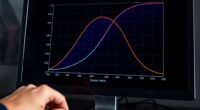Survival analysis helps you understand the timing of events, like failure or death, by focusing on hazard functions that measure how risk varies over time. It accounts for incomplete data, called censoring, which happens when the exact event time isn’t known for some subjects. Properly modeling these hazards and handling censored data guarantees accurate estimates of risk and survival chances. Continue exploring to see how these concepts can be applied effectively.
Key Takeaways
- Survival analysis models the timing of events, focusing on the hazard function to understand how risk changes over time.
- Handling censored data properly is essential to avoid bias, using techniques that incorporate incomplete observations.
- The hazard function indicates the instantaneous risk at any given moment, with higher values signifying greater immediate danger.
- Statistical tools like the Cox proportional hazards model help estimate hazard ratios, assuming constant risk over time.
- Proper modeling of hazard functions and censoring mechanisms provides accurate insights into event timing and risk dynamics.

Have you ever wondered how researchers determine the likelihood of an event happening over time? In survival analysis, this question is central, and understanding the tools used can make it clearer. One key concept is the hazard function, which measures the instantaneous risk that an event, like failure or death, occurs at a specific moment, given that it hasn’t happened yet. Think of it as a way to quantify how dangerous a situation is at any point in time. If the hazard function is high, it means the event is more likely to happen soon; if it’s low, the risk diminishes. This function allows researchers to model how risk changes over the duration of the study, providing a detailed picture of the event’s timing.
But real-world data isn’t always straightforward. Censoring mechanisms often come into play, complicating the analysis. Censoring occurs when the exact time of the event isn’t known for some subjects. For example, a study might end before a participant experiences the event, or a participant might drop out. These incomplete observations can bias the results if not properly handled. Luckily, survival analysis techniques account for censoring, ensuring that the data still provides meaningful insights. They do this by considering the information available up to the point of censoring without making unwarranted assumptions about what happens afterward. Additionally, advances in AI technology have contributed to more sophisticated methods for handling complex censoring scenarios, increasing the robustness of survival analyses.
Understanding the interplay between hazard functions and censoring mechanisms helps you grasp how survival analysis models the likelihood of events over time. When you analyze data, you carefully estimate the hazard function, often using methods like the Cox proportional hazards model, which assumes that the hazard ratios between groups are constant over time. Handling censoring correctly is *vital* here; if ignored, it can lead to underestimating or overestimating risks. Techniques are designed to incorporate censored data efficiently, allowing for unbiased estimates of survival probabilities and hazard rates.
Frequently Asked Questions
How Does Survival Analysis Handle Censored Data?
Censored data can complicate survival analysis, but it’s handled effectively through specific methods. You incorporate censored data by using survival handling techniques like the Kaplan-Meier estimator, which accounts for individuals whose event time isn’t observed yet. This way, you can accurately estimate survival probabilities despite incomplete data, ensuring your analysis reflects the true survival experience. By properly managing censored data, your results become more reliable and meaningful.
What Are Common Pitfalls in Survival Model Assumptions?
You might assume your survival model is perfect, but beware of common pitfalls like model misspecification and ignoring proportional hazards. When your assumptions don’t match reality, results become unreliable, leading to biased conclusions. You should test for proportional hazards, confirm your variables are correctly specified, and consider alternative models if assumptions fail. By doing so, you avoid misleading insights and strengthen your survival analysis’ validity.
Can Survival Analysis Be Applied to Non-Medical Fields?
You can definitely apply survival analysis to non-medical fields like finance, engineering, or customer retention. It helps you understand time-to-event data, such as product failure or customer churn. However, you must consider industry-specific challenges, such as data quality or different event definitions. Adapting survival models to these contexts requires careful thought, but it offers valuable insights into processes that unfold over time beyond healthcare.
How Do You Interpret Hazard Ratios in Practical Terms?
Think of a hazard ratio like a race between two runners. In practical terms, it shows how much more likely one group is to experience an event at any moment. If the hazard ratio is 2, it’s like saying they’re twice as likely to face the event compared to the other group. This helps you understand risks clearly, making it easier to make informed decisions based on the data.
What Software Tools Are Best for Survival Analysis?
When choosing software tools for survival analysis, you want options that support machine learning and data visualization. R offers packages like “survival” and “ggplot2” for detailed analysis and clear visuals. Python’s lifelines library, combined with libraries like matplotlib, enables powerful modeling and visualization. Both tools are user-friendly for beginners and flexible for advanced techniques, helping you interpret your data effectively and make informed decisions based on your survival analysis results.
Conclusion
Think of survival analysis as your trusty compass on a voyage through uncertain waters. It guides you through the fog of incomplete data and unpredictable outcomes, helping you chart a clear course. Just like a sailor relies on the stars to navigate, you can trust survival analysis to illuminate the path forward in understanding time-to-event data. With it, you’re better equipped to steer your research ship safely toward meaningful insights.










